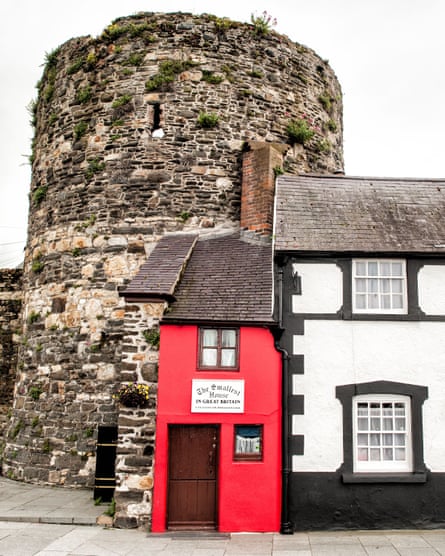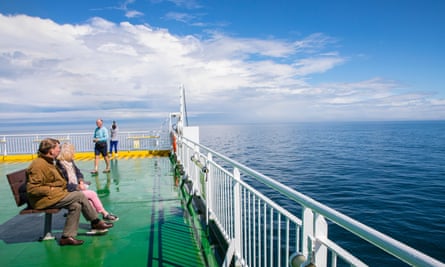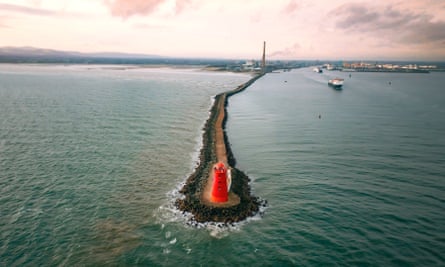How I learned to love the slow route home to Ireland
6 min readThere’s always a moment in the journey from Dublin to London – which I make every month or two, taking the land-and-sea route via Holyhead instead of flying – when I stop what I’m doing – reading or writing or chatting to the person next to me – and think: you don’t get to enjoy this from 40,000ft.
Sometimes it’s at the Britannia Bridge in north Wales. As the train crosses the Menai Strait from Anglesey I can see, off to my right, a concrete statue of Lord Nelson keeping a lonely watch from the shore, and further upriver the grounds of Plas Newydd country house sweeping down to the water. To the left, on a tiny island with a curved jetty, stand two handsome whitewashed houses that will one day disappear beneath the rising sea levels but for now are holding out against the elements.
I’ll pause again as the train trundles past Conwy, with its hulking medieval castle and absurdly pretty waterfront, home to the smallest house in Britain, and later still as we move along the coast beyond Colwyn Bay, and legions of offshore wind turbines can be glimpsed through the haze.
On the return journey, as the ferry heads into Dublin Bay, I’ll cast an eye at Howth Head as it rises up to greet us, followed by the crimson lighthouse at the end of the Great South Wall and the looming red and white chimneys beyond – the unmistakable sign that we’re about to dock in the Irish capital.

People often ask me why I choose to travel between Dublin and London by ferry and rail instead of flying, which is considerably less time-consuming. I’ll respond by talking about the price, or the breezy check-in process with minimal luggage restrictions, or the direct connection into central London, or the carbon emissions, which by one estimate are about 95% lower than going by plane. But the little details – the things you see, the people you meet and the reveries you enter as the journey’s lulling rhythms take hold – matter to me almost more.
When I moved to London in 2002, the idea of taking the slow route home to Dublin didn’t occur to me. Going by air was quick: you can fly city to city in under 90 minutes, though of course you have to factor in the time it takes to get to the airport, clear security, wander through duty-free, wait to board, wait to take off, and go through the associated rigmarole on the other side. And it’s cheap.

Then, about 15 years ago, a friend tipped me off about SailRail, a package that bundled train and Irish Sea ferry tickets into a single fare – connecting not only to London but to any town across Britain with a station. I was dubious about the duration but the price was keen – these days it’s £102.20 return, but back then it was about half that – so I decided to give it a try.
I’ll be honest: I didn’t love SailRailing straight away. Train travel is one of life’s great pleasures but in Britain it can curdle to frustration in the face of delays, cancellations and broken-up routes. It took me a while to work out how to time my journey so I didn’t have to change trains in Crewe and again, 20 minutes later, in Chester. And Holyhead, for all the surrounding beauty of Anglesey, is not a town that makes the heart leap – not, at least, the stretch between the terminal and the ferry dock, which on even the sunniest afternoon feels oppressively grey.
The ships – Irish Ferries and Stena are the two options on the Holyhead-to-Dublin route – can feel dated and a bit tacky, and if you strike out from Dublin on a match day, you have the choice of watching football supporters getting stuck into cooked breakfasts and pints at 8am or joining them. The crossing can be rough, though it would take a serious gale to unsettle one of the bigger boats when its stabilisers are out. (In that kind of weather, I’d rather take my chances on a 50,000-tonne ferry than a dinky commuter plane.)

If you travel with Irish Ferries, which I tend to do, this unfolds within a literary theme park of unparalleled incongruity. The flagship Ulysses is riddled with allusions to James Joyce’s masterwork: you can eat reheated pizza slices (but not pork kidneys) at Boylan’s Brasserie, drink tequila slammers at the Leopold Bloom bar or engage in soft play at the Cyclops family entertainment centre. (The faster ferry, often cancelled if the wind picks up, is ingeniously named the Jonathan Swift.)
Despite – or perhaps because of – these idiosyncrasies, I kept returning for more. For years, I’d SailRail to Dublin and fly back; the journey out of London Euston tends to be smoother, especially if you catch the direct train to Holyhead departing about 9am. But since moving back to Dublin in 2020, I’ve ditched the air option and now actively look forward to my day meandering across the Irish Sea and down through Wales and England. The journey takes eight or nine hours, but without internet to distract me I usually get a solid day’s work done, or at least have time to read and think.
after newsletter promotion

Some distractions are welcome. When the Icelandic volcano eruption grounded European air travel in 2010, I got chatting to two fellow SailRailers on the train out of London. One, delightfully, was the actor who played Gestapo agent Herr Flick in the sitcom ’Allo ’Allo!. The other became a really good friend – and I often thank the ash clouds of Eyjafjallajökull for introducing us.
More recently I’ve fallen into conversation with touring graffiti artists, septuagenarian world travellers and a woman who found God after getting lost in the middle of the Sahara (she prayed for help and a crow appeared to guide her back to safety). Last autumn, when my partner and I took our whippet-saluki over on a morning sailing (pet-friendly cabins are available on Stena) he was lavished with attention by an elderly Traveller couple who told us about similar dogs they’d loved over the years.
The Traveller community uses the ferries a lot, following a route that Irish people with UK connections have taken for centuries. You’ll also encounter plenty of truckers, as well as students, backpackers and people who are averse to flying. What you don’t get a huge number of, among the SailRail contingent, are British tourists. When I mention the package to friends and colleagues in London, few of them have heard of it. And when I tell them the fare, which doesn’t shoot up for last-minute bookings, they’re astonished: £51.10 from London to Holyhead and then on to Dublin by boat? You’re joking, right?

Still, I rarely recommend SailRail without a string of caveats. It isn’t to everyone’s taste. And it could be so much better than it currently is – the rail connections are unreliable and foot passengers on ferries are often treated as afterthoughts. But despite its foibles I’ve come to enjoy the easy pace of the journey and offbeat crowd it throws together. I’ve even developed a fondness for those Joyce allusions.
And I love that long, slow train ride along the north Wales coast, past castles and wind turbines and island houses doomed to vanish beneath the waves. A journey is so much richer and stranger when you travel close to the ground.
SailRail tickets from London Euston to Dublin Ferryport from £102.20 return (+ booking fee) via trainline.com



